As in humans, many animals rely on their senses of sight, hearing, touch, smell and taste to aid survival. Their senses detect information about changes in their environment, allowing them then to respond quickly. (See Human Senses A: Sight and sound and Human Senses B - Smell, taste and touch for greater detail on these senses.) For instance, grass-eating animals would not survive long if they could not hear, smell or see approaching predators!
Animals also use these senses as a basis of communication.
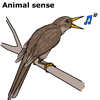 Hearing
Hearing
Sound signals allow complex communication over long distances. Some examples
are: birds and frogs sing to attract mates for reproduction, howler monkeys
call out to warn the troop of danger and also to mark their territory,
and rabbits forewarn others by thumping the ground.
Sight
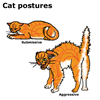 Visual signs can be permanent and continuous (e.g. breeding plumage
of a sexually mature bird), but they are only visible over a short range
and during daylight. Other examples are courtship displays in birds, dominance
displays in gorillas, and facial expressions and body language in humans
and animals, such as dogs.
Visual signs can be permanent and continuous (e.g. breeding plumage
of a sexually mature bird), but they are only visible over a short range
and during daylight. Other examples are courtship displays in birds, dominance
displays in gorillas, and facial expressions and body language in humans
and animals, such as dogs.
Touch
and vibration
 In the dark watery world of the stream bed, a platypus can detect small
prey with touch receptors lining its snout. Social preening in apes, and
human hugs also relay messages through touch. Bees have a complex vibrating
dance language which shows others in the hive the direction and distance
of a food source.
In the dark watery world of the stream bed, a platypus can detect small
prey with touch receptors lining its snout. Social preening in apes, and
human hugs also relay messages through touch. Bees have a complex vibrating
dance language which shows others in the hive the direction and distance
of a food source.
Smell and taste
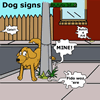 Many
animals produce chemicals (pheromones) for short-term communication purposes.
They are detected either in the air (smell) or in solution (taste). Pheromones
allow individuals to leave odour trails to food sources (e.g. ants), drive
off predators (skunks), delineate territory (urine of foxes and dogs and
scent glands of deer), or to attract mates for reproduction (moths). Salmon
retrace their migration path by detecting the "smell print"
and salt concentrations of the water in the river where they hatched.
Many
animals produce chemicals (pheromones) for short-term communication purposes.
They are detected either in the air (smell) or in solution (taste). Pheromones
allow individuals to leave odour trails to food sources (e.g. ants), drive
off predators (skunks), delineate territory (urine of foxes and dogs and
scent glands of deer), or to attract mates for reproduction (moths). Salmon
retrace their migration path by detecting the "smell print"
and salt concentrations of the water in the river where they hatched.
Other senses used by certain animals include:
Magnetic field
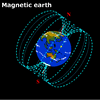 Migratory birds use sight to map geographical features (e.g. mountains)
and celestial markers (moon, stars), but can still navigate on dark cloudy
nights by sensing the direction of the Earth's magnetic field. A small
magnet strapped to a pigeon's back affects its ability to innately locate
"north"!
Migratory birds use sight to map geographical features (e.g. mountains)
and celestial markers (moon, stars), but can still navigate on dark cloudy
nights by sensing the direction of the Earth's magnetic field. A small
magnet strapped to a pigeon's back affects its ability to innately locate
"north"!
Infrared heat
Rattlesnakes locate warm-blooded prey (e.g. mice) by heat sensitive infrared
detectors which can detect a 0.005°C rise in temperature at a distance
of 15cm.
Electrical impulses
Electric eels, and certain fishes and rays convey messages by emitting
and detecting electric impulses.
The platypus can sense electrical fields from the nervous system of certain prey e.g. shrimp.
Echolocation
Bats can both navigate and locate food in total darkness using echolocation.
They emit high frequency ultrasonic sounds (beyond the upper limit of
human hearing) and, from the echo, they can judge distance, size, texture
and shape. The bat brain then processes all this information, forming
a picture of its surroundings, as humans do using sight.
The strange nose shape of the bat enables it to focus the sound like
a flashlight beam and alter its frequency depending on the need. For example,
flying through an open field requires less precise detail than catching
small insects. Tiny muscles in the inner ear disconnect the hearing apparatus
when sounds are emitted to prevent the bats deafening themselves! To allow
them to hear the echoes between emitting noises, bats' ears may need to
be switched on and off 200 times per second!
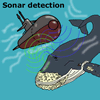

|
Bat sense |
| Copyright owned by the State of Victoria (Department of Education and Early Childhood Development). Used with Permission. |